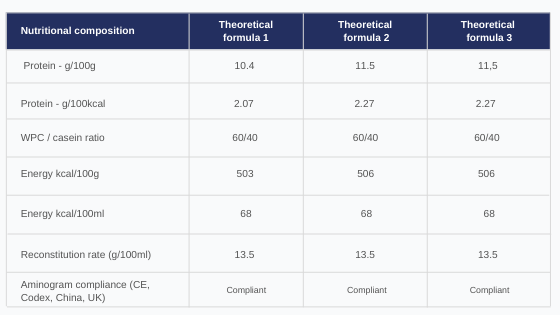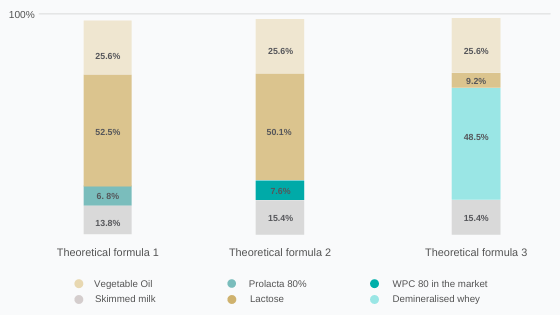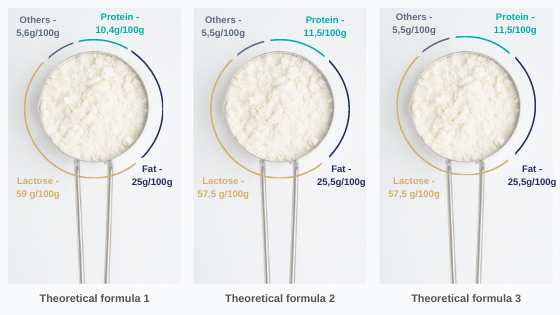
The value of dairy ingredients in infant formulas
Infant formulas are designed to cover the nutritional needs of infants, as a complement to, or to follow on from breast-feeding for babies and up to the age of three. Breast milk is the ideal food to provide a baby with the nutrients it needs.
Infant powders are formulated to ensure infant development and growth. Products are classed by age following specific regulations.
-
-
- Infant formulas 0–6 months:
-
The product must cover the essential nutritional needs for the baby to develop properly It is the only food consumed prior to dietary diversification. Its composition should be as close as possible to breast milk.
-
-
- Infant formulas 6–12 months:
-
Weaning generally starts between 4 and 6 months.
Infant formula is no longer the only food consumed by the infant, but it remains the main source of energy and essential nutrients.
-
-
- Follow-on milk 12 months:
-
Not all nutritional requirements are always covered by the general diet, particularly iron and essential fatty acid requirements. It is recommended to use follow-on milk until the child reaches the age of three, to complement their diet.
Dairy ingredients are essential in formulating infant formulas to obtain a nutritional composition that is similar to breast milk.
Dairy ingredients are essential in formulating infant formulas to obtain a nutritional composition that is similar to breast milk.
Dairy protein content
Breast milk has a protein content close to 1.3 g/100 ml or 2 g/100 kcal. The type of protein in breast milk is different to that of cow’s milk. Breast milk contains mainly whey proteins while cow’s milk contains mainly casein.
The most significant protein in breast milk is alpha-lactalbumin, which accounts for an average of 27% of breast milk protein. Alpha-lactalbumin is also present in the whey proteins of cow’s milk, but at a lower concentration, around six times less than in breast milk.
Infant formulas are formulated to be as close as possible to the protein content of breast milk. They usually contain between 1.8 g/100 kcal and 2.5 g/100 kcal at most.
Minimum intakes of essential amino acids are also defined by regulations and based on the average composition of breast milk.
The quality and composition of the proteins are therefore essential to provide adequate quantities of essential amino acids while maintaining the recommended protein level of around 2 g/100 kcal.
The quality and composition of the proteins are therefore essential to provide adequate quantities of essential amino acids.
Because the skimmed milk used to make infant formulas contains mainly casein, the addition of whey protein is necessary. This can be added using dairy ingredients with different sources, manufacturing processes, amino acid profiles or protein concentration levels:
-
-
- Prolacta® 80 is a soluble protein concentrate, obtained directly from milk by physical separation and concentration processes. It is suitable for infant formulas due to the high true protein content, particularly alpha-lactalbumin, the principal protein in breast milk. Its amino acid composition means protein levels can be reduced to the recommended level, particularly thanks to its high tryptophan content.
-
-
-
- Other WPCs on the market are derived mostly from whey and provide whey proteins (beta-lactoglobulin and alpha-lactalbumin) to balance the intake of essential amino acids. WPCs are classed according to their protein content. The most commonly used WPCs in infant nutrition are WPC 80 (80% Pure Protein/Dry Matter) and WPC 35 (35% PP/DM). The other elements provided by these WPCs are lactose, residual milk fat, minerals, and vitamins.
-
-
-
- The 90% demineralised whey consists mainly of lactose but also contains whey protein (10–12% PP/DM). Whey is highly demineralised to be compatible with the mineral content of infant formula.
-



Figure 1: Theoretical formulas and their nutritional composition
Lactose content:
Lactose is the reference carbohydrate for infant formulas as it is predominant in breast milk.
All infant formulas are made with lactose. The highest quality formulas contain more than 90% of lactose as a source of carbohydrates, with no other added sugars or maltodextrins. Except in the case of certain pathologies, infants generally have no difficulty in naturally hydrolysing the lactose present in breast milk or infant formulas.
Different qualities of lactose are available. White lactose is the most suitable for ensuring a consistent level of vitamin B2 in infant formulas. Indeed, its specific manufacturing process increases the purity level of lactose by removing the vitamin B2 that is naturally present in large quantities in milk and whey.
The use of white lactose in infant formulas helps avoid seasonal variations in the vitamin B2 content of milk. The finished product is therefore of a consistent quality while ensuring the product complies with current regulations and nutritional labelling standards.
Lactose is the reference carbohydrate for infant formulas as it is predominant in breast milk.
Dairy ingredients are widely used and adapted to develop infant formulas that are as close as possible to the nutritional composition of breast milk. They represent 60 to 80% of the total weight of the formula.















